-
Posts
6,486 -
Joined
-
Last visited
-
Days Won
10
Content Type
Profiles
Forums
Blogs
Gallery
Events
Store
Posts posted by Brian Wolfe
-
-
hi brian. pc charles brown joined on the 31/05/1886. on the 01/09/1890 pc brown 72 3rd divn to pc brown 423v v.divn (police order date 05/09/1890).18/01/1896 pc brown 423v to pc brown 7vr v.divn (reserve)( po 14/01/1896).14/04/1898 pc brown 7vr to ps 27f f.divn (po 15/04/1898).30/03/1901 ps brown 27f to sps 32y y.divn ( 01/04/1901).10/01/1903 sps brown 32y to insp x divn (po 12/01/1903 ).07/11/1908 insp brown to reserve (po 20/10/1908).03/06/1912 insp brown x divn pensioned. on the day he joined the police orders does not give any division for him, I cant see any movement between the day he joined 31/05/1886 to 01/09/1890 from when he was in 3rd division. Sometimes the police orders database are a bit thin on early movements of officers. In the book by J Kemp his 1887 coronation medal was to the V Div. Hope this info helps you in any way. going to the national archives this week and will look at his papers paul
Thanks for the information and thank you for offering to check further at the archives.
I look forward to what you will find.
Regards
Brian
0 -
Supt Olive & Chief Insps and Insps....
Sygrove
Collison
Whittle
Ball
Dingle
Douglas
Baxter
Reid
Taylor
Macer
Ricketts
Perry
Instance
Dauncey
Sellors
Cosgrove
Morgan
Barrett
Parker
Lvie
Richards.
X Div
Hi Gordon,
Interesting that his name does not show up. Thanks for taking the time to look him up.
Regards
Brian
0 -
Here's a couple of photos of the naming.
Brian
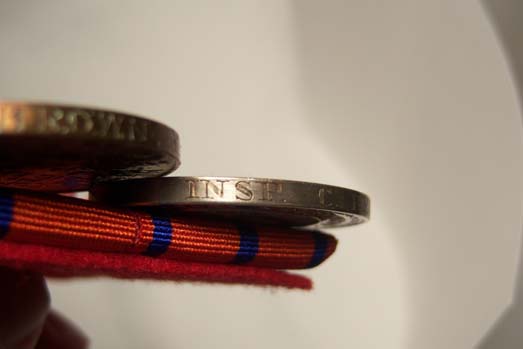
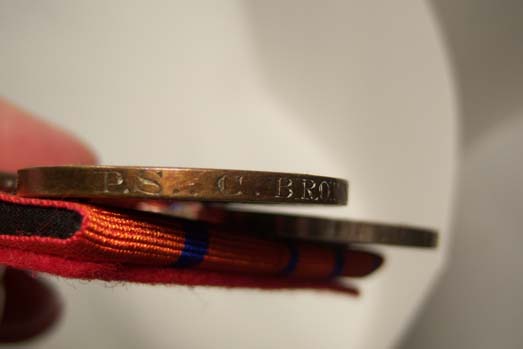 0
0 -
Hello Everyone,
A nice pair of Metropolitan Police Coronation Medals came my way a few months ago and I have just completed the court mounting of them. They are named to Warrent No. 71791 PS and Insp. C.Brown.
The 1902 medal is named to Police Sergeant C. Brown.
The 1911 medal is named to Inspector C. Brown
He joined the service on 31/05/1886 and retired out as an Inspector on 03/01/1912.
He served in V Division (Wandsworth) in 1886 as a PC and research shows he would have been awarded the 1887 Jubliee Medals as well as the 1897 clasp.
In 1902 he was served in Y Division (Highgate) as a Police Sergeant.
1911 found him in X Division (Kilburn) with the rank of Inspector.
An interesting career spanning the reign of three monarchs.
Regards
Brian
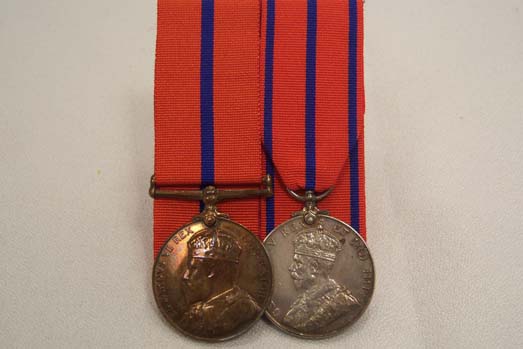 0
0 -
I am coming to this very late but here are my two cents worth. The pattern forage cap shown (with large crown) was introduced into Canadian service in 1899 and was originally known as the Staff Pattern or Naval Pattern. By 1902 it had virtually relaced the previous model (pill box style). By 1907 the white summer cover had been ordered out of wear.
The Blue field service cap (wedge cap) worn by the Other Ranks was popular from about 1890 to 1905. In 1903 the Canadian Militia introduced khaki service dress but issues to 'rural' regiments was postponed due to budget so these regiments continued to wear the 'coloured' (read Scarlet/Blue/Green) uniforms. I would put this image at 1900-1905 as the Long Lee-Enfield had not yet been issued throughout the Militia yet.
my tuppence worth.
Clive
Many thanks Clive.
Regards
Brian
0 -
Some of these private museums, while topic specific, are well worth the time to visit. This looks like one of them.
Thanks for posting these images Harry.
This makes me want to now get at straightening up my own collection room.
Regards
Brian
0 -
Hello Chris and Bernhard,
Good points and not ones I am prepared to debate, due to lact of expertise, so I bow to yours.

It's much like current events, there is a lot of propaganda to sift through and still the anwswer may never be clear.
Regards
Brian
0 -
Hello Chris.
I noticed the distributor of the card. For those who may not read German: "German Center for ending the Boer War, Munich". I was aware that a sizable number of Germans were in sympathy with the Boers. As a youth we used to read lots of cheap booklets glamorizing the Boers' stand against the British. More serious reading I only began once I had easier access to such books.
Bernhard H. Holst
Hello Bernhard,
One of the great things about discussions of events and politics from over 100 years ago is that one has a chance to cut through the propaganda and political double talk of the past. Many of the members know me as an Anglophile though I also have German ancestory. Having said that, I read from your comments that "now" you do not feel as though the Boers made a brave and righteous stand against empirical expansionism driven as much for financial gain as anything else. I trust that due to the age of this topic's events it is not fuel for a political tirade from anyone but rather the grounds for a discussion of historical accuracy. Also not to take away from the actual combatants, many of them who died fighting for what they believed to be a just cause, do you not feel that this was a case of the British public and military machine being mislead by those with monetary gain in mind? Perhaps I should open this question up in a more appropriate secion of the forum specific to this time period.
Any thoughts on this topic?
Regards
Brian
0 -
Hi Mervyn,
As a young boy I would attend the cinema with my parents and when any news reel, adventure movie or documentray depicting the "real" africa was shown I'd sit there holding my breath with awe and wonder at such places and people. Reviewing your resent acquisitions brought back the memory or those days.
Thank you for posting thiese postcards and making my Sunday morning even more enjoyable than usual.
Regards
Brian
0 -
Brett - what an unusual item. Stoneage, but of a modern material. The quality of the 'flaking' to obtain an edge is very finally done and I wouldn't think glass would 'nap' as well as flint - more likely to splinter ? I know many South American tribes use volcanic glass - obsidian - but I think that is a harder material then bottle glass.
Hi Mervyn,
On the Moh's scale glass rates 6 to 7, quartz is around 7 while obsidian only rates 5 to 5.5. I would think glass would be more difficult to nap than obsidian. Perhaps one of the members who has had experience with making arrow heads will comment.
(Moh's scale rating of 1 to 10 is based on Talc = 1 and Diamond = 10)
Regards
Brian
0 -
Hello Malarky,
You have a very nice collection and your English is excellent. I too started collecting Japanese medals about the same time as you and I must say your collection is as excellent as your English.

I hope you will continue to show your new additions as they arrive.
Regards
Brian
0 -
The container has done its job admirably.
I once asked, at the local post office, just how much good "Fragile" stickers and tape did.
They just laughed at my question.

I suppose that, in fact, answered my question.
At least the contents were undamaged Stuart.
Have you posted this particular pillbox cap yet?
Regards
Brian
0 -
Brian - I'm so pleased that you have revived this post. The year bars are quite exceptional and I don't think I've seen so many before - he didn't need a truncheon - he could have 'flogged them to death' with the chain....
I was wondering if his rank of Sgt. applied to his Police or St. John's? Was the rank specific to both - or, earned separately ? Never really thought about it before.
The rank of Sgt. was on the St. John medal only so I am thinking it was not a police rank he had at the time the SC medal was awarded.
Brian
0 -
Brian,
Sorry,I didn't see your reply to Mervyn's post before I posted a new topic on if we should have a seperate Forum or section for "items that don't fit".
Bob
Hi Bob,
Not a problem at all.
Regards
Brian
0 -
Hello Mervyn,
A fasinating weapon from an equally fasinating culture. A culture still living in the stone age within our living memory. Well, the living memory of you and me.
I agree that there may be enough interest in ancient weaponry among the membership to support a section for such items and discussion. Many of the military tactics that worked successfully in the recent past had their roots in the tactics employed in the distant past.
Thank you for posting this interesting artifact and broaching the suggestion of a new section.
Regards
Brian
0 -
Last, but not least, the membership bars showing the two dates where the new design came into use.
I think this is an interesting grouping and it's one of the jewels of my SC collection.
Regards
Brian
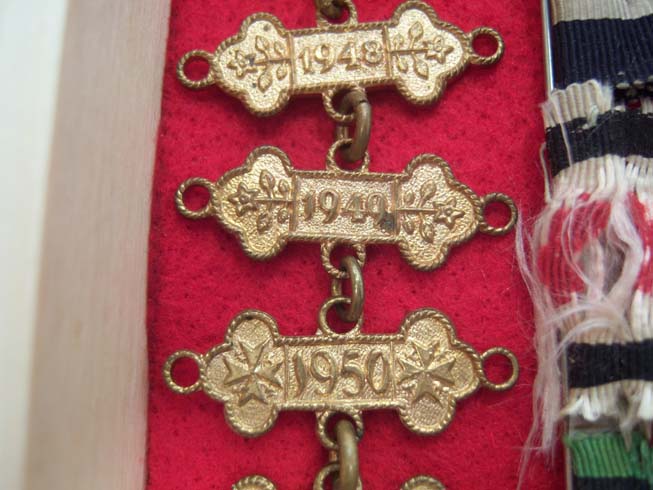 0
0 -
Here is a closer view of the St. John Ambulance Long Service Medal and the membership badge.
 0
0 -
Hello Everyone,
Once you have pretty well a complete "type set" of the Special Constabulary Long Service medals, plus the different clasps, what do you collect? Well, for me it was groups which included the SCLSM. One such interesting group is the one I offer for your enjoyment today. As may be seen in the photo the group includes the Defence, SC Long Service and a St. John Ambulance Brigade Medal (S.J.A.B.). Along with the medals came a literal chain of annual membership bars to the St. John Ambulance Association badge. He was a member, according to the "chain" from 1939 (1940 probably marks the first full year of service) until 1961.
An interesting feature of this chain is that it shows the change in design of the membership bars occured with the 1950 bar, which predates the reign of Elizabeth II. I would have thought any change in design to coincide with a change of monarch but I guess the plans were in place before Geo. VI passed away.
This group is named to William C. Holley with the S.J.A.B. medal named to Sgt. W.C. Holley, Hants. From what I can find out "Hants" stands for Hampshire. If this is incorrect perhaps one of the members can set me straight.
I hope you like this intersting little grouping. I left them in their drawer for the photos as the robbons are very fragile.
Regards
Brian
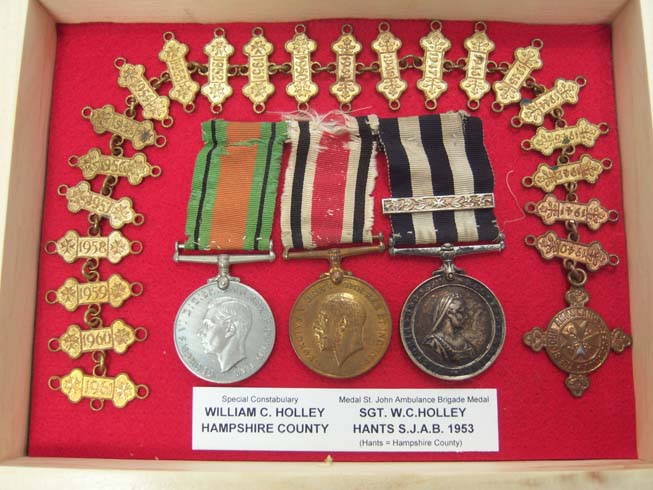 0
0 -
Somehow I missed this post the first time around but I'm happy I saw it this time.
Great uniform Mervyn.
Re: Specials section, I do have some items to post with the hope of kick-starting the section up once again.
I'll see what I can do later today.
Regards
Brian
0 -
Hello Valter.
Thanks for posting this interesting medal bar, I wish I could help you with the identification.
Perhaps you should post this on the Imperial German section so some of the more informed members can see it and perhaps tell you what is missing.
Regards
Brian
0 -
An interesting post. I have heard of these but never saw one.
Thanks for enlightening me.
Regards
Brian
0 -
I'm assuming the other medal is an IGS 1854, bar Samana 1891. I can't find him on the roll on Ancestry under Boardman. The 1903 roll shows him as "Deceased".
Hi Michael,
The medal I have posted to Boardman is his only entitlement, from what I was told.
It was the other gentleman with the IGS.
That is interesting that he is shown as deceased in 1903.
Regards
Brian
0 -
Brian, I think the PMs are going through ... but is this the error you got?
Yes, that's the one.
I see today that Nick has corrected this problem.
I'll know as soon as I try to send this.

Regards
Brian
0 -
Brian, I have a copy of the actual medal roll if you would like it ...
Send me a PM with your email address and I'll fire them off to you

Hello Darrell,
Thank you for you kind offer it is most appreciated. It seems like the PM function is down at the moment and the two attempts to send you a message "failed". So they either didn't get through or you now have two PMs.

My mailing address is,
Brian Wolfe
171 Eby Crescent
New Hamburg, ON
N3A 1Y8
Canada
Thanks again.
Regards
Brian
0




Metropolitan Police Coronation Medals
in Great Britain: Mervyn Mitton's British & Colonial Police Forces
Posted
That sounds like a great group, I would have liked to have seen it.
If only we could keep everything we ever collected.
Regards
Brian